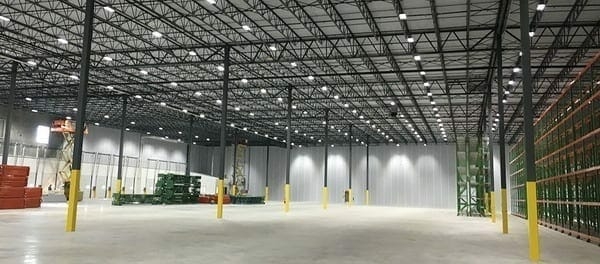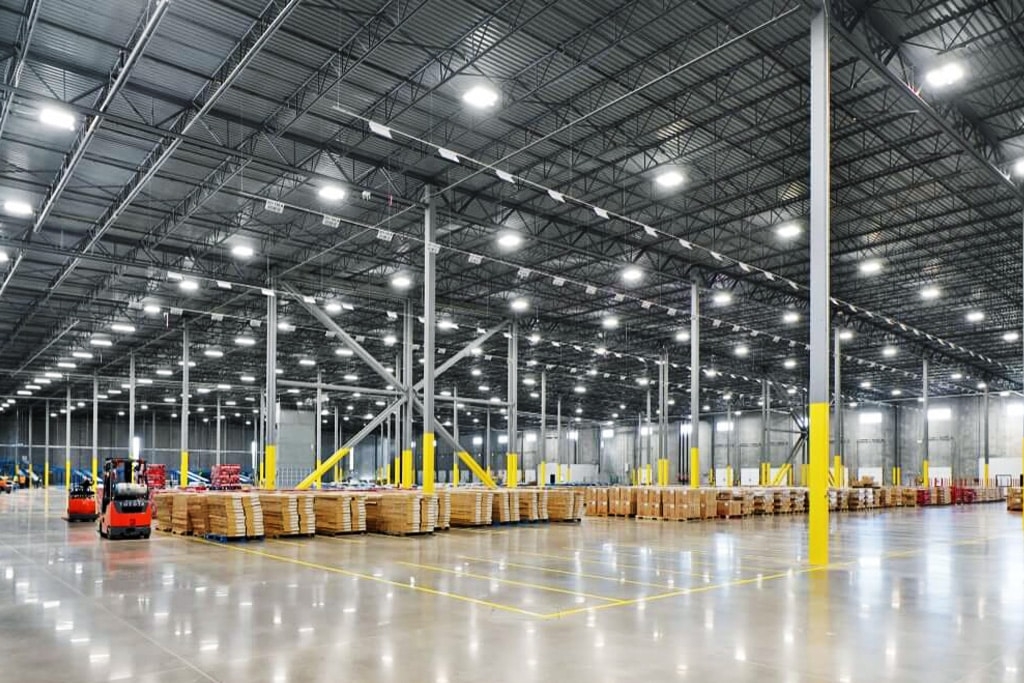Efficient industrial warehouse lighting extends far beyond mere convenience; it stands as a pivotal factor with profound implications for operations, safety, and the overall prosperity of these facilities. Within the realm of warehouse infrastructure, proper lighting holds indispensable significance. This introduction is a gateway to understanding why efficient lighting is irreplaceable within industrial warehouses, serving as the bedrock of their functionality.
Efficient lighting is an intrinsic component that exerts influence over safety, productivity, energy conservation, regulatory compliance, and the well-being of employees within industrial warehouses. Acknowledging its paramount importance provides the groundwork for our exploration of the multifaceted aspects of warehouse lighting and how optimization can yield benefits for both businesses and their workforce.
Brighter Operations: The Advantages of Proper Warehouse Lighting
Enhanced Safety for Workers and Equipment
Proper warehouse lighting is synonymous with a safer work environment. It minimizes the risks associated with accidents and injuries, safeguarding the well-being of both employees and valuable equipment. Well-illuminated pathways, machinery, and storage areas reduce the likelihood of collisions, slips, trips, and falls, fostering a secure atmosphere where workers can perform their tasks with confidence and without unnecessary hazards.
Amplified Productivity and Efficiency
The advantages of proper lighting extend to elevated productivity and efficiency within industrial warehouses. When workers can see clearly, they work more accurately and swiftly, resulting in streamlined operations. Reduced errors, faster task completion, and improved picking accuracy all contribute to enhanced workflow, translating into increased overall productivity and output.
Substantial Energy and Cost Savings
Efficient warehouse lighting doesn’t only brighten the workspace; it also illuminates the path to cost savings. Implementing energy-efficient lighting solutions can significantly reduce operational expenses over time. These technologies, such as LED lighting and smart lighting systems, consume less energy, resulting in lower electricity bills. Additionally, their longer lifespans mean reduced maintenance and replacement costs, making them economically advantageous choices.
Adherence to Regulations and Standards
Industrial warehouses often operate within a framework of regulations and safety standards. Proper lighting plays a pivotal role in meeting these requirements. Compliance with prescribed illumination levels and lighting standards ensures that warehouses adhere to legal mandates, avoiding potential penalties and creating a secure and lawful working environment for all stakeholders.
The benefits of proper industrial warehouse lighting encompass improved safety, heightened productivity, cost savings, and regulatory compliance. These advantages underscore the vital role that effective lighting plays in enhancing the overall functionality and success of industrial warehouses.
Diverse Warehouse Lighting Solutions
High-Intensity Discharge (HID) Lighting
High-Intensity Discharge (HID) lighting has been a traditional stalwart in warehouse illumination. This category includes metal halide and high-pressure sodium lamps, known for their ability to cast potent, far-reaching beams of light. HID lights excel in environments with high ceilings, which are often characteristic of industrial warehouses. However, they do come with certain limitations, including longer warm-up times and greater energy consumption when compared to more modern alternatives.
LED (Light Emitting Diode) Lighting
The ascendancy of LED lighting as the preferred choice for warehouse illumination has been rapid and well-founded. LED lights are celebrated for their exceptional energy efficiency, consuming substantially less electricity than conventional lighting sources. They offer instant illumination without the need for warm-up periods and boast an extended lifespan, resulting in reduced maintenance costs. LED fixtures come in a variety of color temperatures, allowing for adaptable lighting that can enhance visibility and worker comfort. Their versatility and cost-saving benefits have positioned them as an ideal choice for contemporary industrial warehouses.
T5 and T8 Fluorescent Lighting
T5 and T8 fluorescent lighting have been enduring options in warehouse illumination due to their efficiency and uniform light distribution. These fluorescent fixtures emit bright, diffused light that effectively covers expansive areas. T5 lamps, in particular, stand out for their energy efficiency and more compact diameter, making them suitable for environments with limited ceiling space. While not as energy-efficient as LEDs, fluorescent lighting remains a practical choice for warehouses seeking cost-effective solutions.
Harnessing Natural Lighting
Natural lighting solutions leverage sunlight to illuminate warehouse spaces, typically employing elements such as skylights, translucent roof panels, and expansive windows. These strategies offer the advantage of reducing energy consumption during daylight hours while creating a more pleasant work environment. However, reliance on natural lighting may necessitate supplementary artificial lighting on overcast days or during nighttime operations. Thoughtful design and placement of these elements are pivotal in optimizing their efficacy within warehouses.
A spectrum of warehouse lighting solutions exists, each with its own array of merits and considerations. The selection of lighting technology should be aligned with the unique requirements of a warehouse, encompassing factors like ceiling height, energy efficiency objectives, and maintenance prerequisites. Warehouse managers must meticulously evaluate these options to pinpoint the lighting solution that best harmonizes with their operational needs and fiscal constraints.
Considerations in Selecting Warehouse Lighting
Warehouse Layout and Design
1) Ceiling Height: The height of the warehouse ceiling is a crucial factor in choosing lighting. High-ceiling warehouses may require fixtures that provide sufficient illumination at greater heights, such as high-intensity discharge (HID) or LED high bay lights. Lower-ceiling warehouses can make use of a wider range of lighting options.
2) Racking Configuration: Consider the layout of racks and storage systems within the warehouse. Ensure that lighting fixtures are strategically positioned to minimize shadows and dark spots, optimizing visibility for workers navigating through the aisles.
Lighting Placement and Spacing
1) Uniform Distribution: Aim for even and consistent light distribution throughout the warehouse. Proper spacing and placement of fixtures help achieve this goal, reducing the risk of over-illuminated and poorly lit areas.
2) Task-Specific Lighting: Identify areas where task-specific lighting may be necessary, such as workstations, assembly lines, or inspection areas. Supplement general lighting with task lighting to enhance worker productivity and accuracy.
Light Quality and Color Temperature
1) Color Rendering Index (CRI): Consider the CRI of lighting fixtures. A higher CRI ensures that colors are rendered accurately, which is essential in tasks that require color differentiation, like quality control and inspection.
2) Color Temperature: Choose the appropriate color temperature (measured in Kelvin) to match the tasks performed in the warehouse. Warmer color temperatures (around 2700-3500K) can create a more comfortable ambiance, while cooler temperatures (4000-5000K) are suitable for tasks requiring precision and focus.
Energy Efficiency and Sustainability
1) LED Technology: LED lighting is a highly energy-efficient option that reduces electricity consumption and operating costs. Consider LED fixtures for their long lifespan and minimal heat generation, which can contribute to both energy and maintenance savings.
2) Sensor and Control Systems: Implement occupancy sensors, daylight harvesting controls, and programmable lighting schedules to optimize energy usage. These systems automatically adjust lighting levels based on occupancy and natural light availability.
3) Environmental Impact: Assess the sustainability of lighting solutions. Look for fixtures and technologies that minimize environmental impact, such as those with recyclable components or reduced hazardous materials.
4) ROI and Payback Period: Evaluate the return on investment (ROI) of lighting upgrades. Calculate the payback period based on energy savings and reduced maintenance costs to determine the economic benefits of upgrading to more energy-efficient lighting.
By considering these factors when selecting warehouse lighting, businesses can ensure that their lighting solutions are tailored to the unique needs of their facility. Proper lighting design not only enhances safety and productivity but also contributes to long-term energy savings and environmental sustainability.
CONCLUSION
In conclusion, the significance of efficient and well-planned industrial warehouse lighting cannot be overstated. It goes beyond mere illumination; it impacts safety, productivity, cost savings, and environmental sustainability. By investing in the right lighting solutions, businesses can create safer and more efficient work environments, reduce energy costs, and adhere to regulatory standards.
As technology advances and sustainability efforts grow, the future of warehouse lighting looks promising. Embracing innovative and eco-friendly lighting technologies will not only benefit individual businesses but also contribute to a more sustainable and responsible industrial landscape.
Post time: Oct-17-2023






